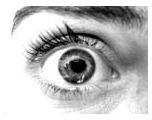Parallax and its Effect on Vision: An Elementary Classroom Activity
Prelab Preparation
Before beginning the activity, have students read through the activity in its entirety. Before beginning, discuss the following points:
-
Emphasize the importance of understanding all of the directions before beginning the activity.
-
Point out the path of light to each eye and discuss how the individual images reach the brain.
Collect the following materials:
- ruler or tape measure
- chalk
- paper
- masking tape
- long pencil
- copy of data table
At eye level, draw 11 parallel, vertical lines 10 cm apart on the chalkboard. Label the line on the left with 0, the next line 10, and so on, until you have a metric ruler on the chalkboard. Measure 4 m straight out from the 50 cm line on the chalkboard and place a piece of tape on the floor to mark the spot. Then, also mark with tape the places on the floor that are 3, 2, and 1 m from the chalkboard.
Procedure
-
Stand at the 4m mark, facing the chalkboard.
-
Have a partner hold the pencil vertically exactly over the 3m mark, so that the pencil is 1m away from your face. The pencil should remain as still as possible.
-
Use your left eye to observe the pencil’s position against the lines on the chalkboard. Estimate this apparent position in cm. Record this observation in your data table.
-
Without moving your head or the pencil, repeat step 2. This time, observe with your right eye. Record the result.
Analysis
-
The apparent change in the position of the pencil, in relation to the lines on the chalkboard, is called parallax. Calculate the parallax for your two observations in cm. Record your answer in the data table. (Answers will vary due to varied pupil-to-pupil distances among individuals and due to the placement of the sighting pencil. Check that parallax is calculated accurately from the presented data.)
-
Predict how your data will change when you move the pencil farther away from your face. Discuss and compare your predictions with your classmates. (The farther away the pencil is from the eyes, the smaller the difference between the two positions.)
-
Repeat steps 2 and 3 under Procedure, having your partner hold the pencil 2m and then 3m away from your face. Record your data and calculate the parallax for each pair of left-eye and right-eye observations. (Answers will vary. Check calculations for accuracy.)
Conclusion Activities
-
How does the position of an object appear to change when you look at it with only one eye and then with the other? (The object will appear to move to a position opposite the eye viewing it. If viewing the pencil with the left eye and change to the right eye, the pencil will appear to move to the left.)
-
What is the relationship between the amount of parallax and your distance from the pencil? (The closer to the pencil, the greater the parallax.)
-
Most of the time you look at objects using both of your eyes. Why do you think people have two eyes instead of just one? (Accept reasonable explanations. Parallax allows a perception of depth, which is an advantage in running and working with hands.)
